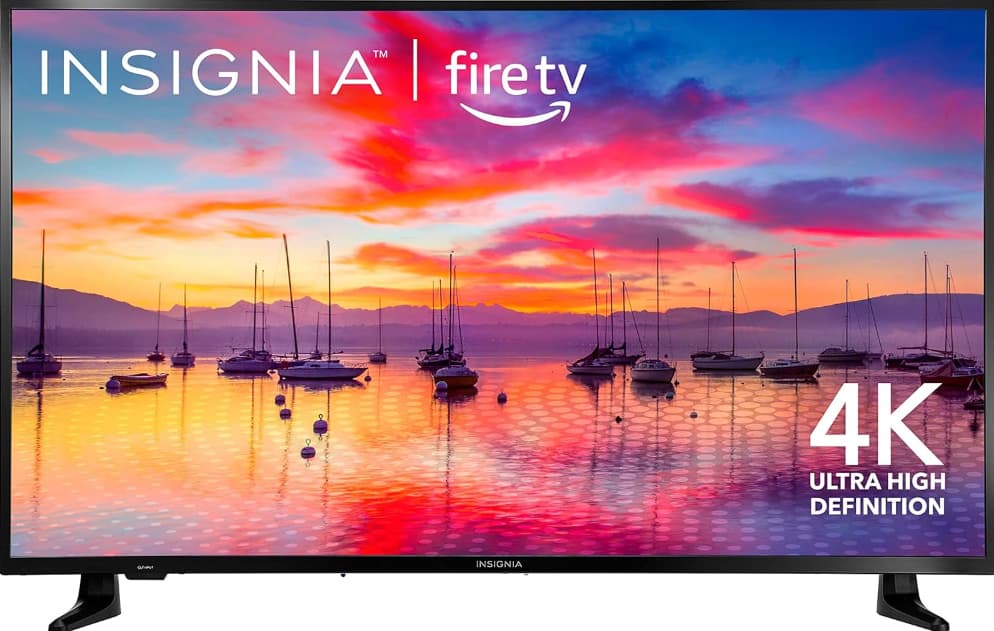When you’re in the market for a new television, you might come across the Insignia brand, especially if you’re browsing at Best Buy or looking for budget-friendly options.
This naturally leads to the question: “Who Makes Insignia TVs?” It’s a query that many consumers have, given the brand’s popularity and competitive pricing in the television market.
Insignia TVs have gained a reputation for offering a good balance of features and affordability, making them an attractive choice for many shoppers.
However, unlike well-known brands such as Samsung, LG, or Sony, the name Insignia doesn’t immediately reveal its origins or manufacturing process.
Who Makes Insignia TVs?

In this comprehensive guide, we’ll dive deep into the world of Insignia TVs.
We’ll explore the brand’s background, its relationship with Best Buy, and the intricacies of its manufacturing process.
By the end, you’ll have a clear understanding of who’s behind these popular budget TVs and what that means for you as a consumer.
Whether you’re considering purchasing an Insignia TV or simply curious about the brand, this exploration will provide valuable insights into the company’s place in the competitive television market.
Also Check: How to Use Insignia TV Remote & Pair to TV
Insignia: Best Buy’s In-House Brand
To truly understand Insignia TVs, we need to look at their origin and relationship with Best Buy. Insignia isn’t a standalone company – it’s what’s known as a “house brand” or “private label” owned by Best Buy.
Best Buy launched the Insignia brand back in 2004 with a clear goal: to offer customers good-quality electronics at more affordable prices than big-name brands.
Over the years, they’ve expanded the Insignia line to include various products, but TVs remain one of their most popular offerings.
Here’s why Best Buy created Insignia:
- Competitive pricing: By cutting out the middleman and working directly with manufacturers, Best Buy can offer lower prices.
- Control over features: Best Buy can decide exactly what features to include based on customer feedback and market trends.
- Higher profit margins: House brands often provide better profits for retailers than selling other brands.
- Customer loyalty: A good experience with an Insignia product can increase customer loyalty to Best Buy.
The Insignia brand has grown significantly since its inception. It’s now recognized as a reliable budget option in the TV market.
Best Buy’s deep understanding of consumer electronics and customer preferences has played a crucial role in shaping Insignia’s product lineup.
When you buy an Insignia TV, you’re essentially getting a product that Best Buy has specifically designed to meet the needs of budget-conscious consumers.
They’ve used their years of experience selling TVs to create a brand that offers the features most people want at an attractive price point.
Manufacturing and Production
The process of bringing an Insignia TV to life is more complex than you might think. While Best Buy owns the brand and makes the big decisions, the actual manufacturing involves a network of partners and suppliers.
Let’s break down this process to understand how Insignia TVs come to be.
1. Design and Specification
Best Buy starts by deciding what kinds of TVs they want to offer under the Insignia brand. They consider factors like:
- Current market trends
- Customer feedback
- Price points they want to hit
- Features that are in demand
2. Partnering with Manufacturers
Once they have a clear idea of what they want, Best Buy works with manufacturing partners. These are companies that have the facilities and expertise to produce TVs. Some key partners include:
- Hisense
- TCL
- Foxconn
These companies are chosen based on their ability to meet Best Buy’s quality standards and price requirements.
3. Sourcing Components
The manufacturing partners don’t make every part of the TV themselves. Instead, they source components from various suppliers. Some important components and their typical suppliers include:
- LCD panels: Often from companies like LG Display or Samsung Display
- Processing chips: From firms like MediaTek
- LED backlights: Various specialized suppliers
4. Assembly
With all the components in hand, the manufacturing partners assemble the TVs according to Best Buy’s specifications. This process involves:
- Putting together the physical components
- Installing the necessary software
- Calibrating the display
5. Quality Control
Before leaving the factory, each TV goes through quality control checks to ensure it meets the required standards. This might include:
- Picture quality tests
- Sound tests
- Durability checks
6. Packaging and Shipping
Once approved, the TVs are packaged (often in boxes designed to minimize environmental impact) and shipped to Best Buy’s distribution centers.
7. Distribution
From the distribution centers, the TVs are sent out to Best Buy stores or directly to customers who order online.
This complex process allows Insignia to offer TVs that balance quality and affordability.
By leveraging the expertise of established manufacturers and component suppliers, Best Buy can create TVs that meet their specifications without the high costs associated with running their own manufacturing facilities.
Here’s a simple table summarizing the key players in Insignia TV production:
| Role | Who Does It | What They Do |
|---|---|---|
| Brand Owner | Best Buy | Decides on features, manages the brand |
| Manufacturers | Hisense, TCL, etc. | Assemble the TVs |
| Component Suppliers | LG, Samsung, MediaTek, etc. | Provide crucial parts |
| Quality Control | Manufacturing partners | Ensure TVs meet standards |
| Distribution | Best Buy | Get TVs to stores and customers |
Insignia TV Features and Specifications
Insignia offers a wide range of TVs to cater to different needs and budgets. While the specific features can vary between models, there are some common characteristics you’ll find across the Insignia TV lineup.
Let’s dive into the key features and specifications:
1. Display Sizes
Insignia TVs come in a variety of sizes to fit different spaces:
- Small: 19″ to 32″ (great for bedrooms or small spaces)
- Medium: 40″ to 55″ (popular for living rooms)
- Large: 65″ to 75″ (for those who want a more cinematic experience)
2. Display Technology
Most Insignia TVs use LED-LCD technology:
- LED backlighting for better energy efficiency
- LCD panels for the actual display
Some higher-end models might feature:
- QLED technology for enhanced color and brightness
3. Resolution
Insignia offers TVs with different resolutions:
- 720p (HD): Usually on smaller, more affordable models
- 1080p (Full HD): Good for mid-range options
- 4K (Ultra HD): On larger, more premium models
4. Smart TV Capabilities
Many Insignia TVs come with smart features:
- Fire TV or Roku TV platforms have built-in
- Access to popular streaming services like Netflix, Hulu, Amazon Prime
- Voice control capabilities (with compatible models)
5. Connectivity
Typical connectivity options include:
- HDMI ports (usually 2-4 depending on the model)
- USB ports
- Digital audio output
- Ethernet port (on smart TV models)
- Wi-Fi (on smart TV models)
6. Audio
While not typically a standout feature, Insignia TVs usually have:
- Built-in speakers (often 2 x 5W or 2 x 10W)
- Audio enhancement technologies like DTS TruSurround on some models
7. Design
Insignia TVs generally feature:
- Slim bezels for a modern look
- Sturdy stands (wall-mounting is also usually an option)
8. Additional Features
Depending on the model, you might find:
- HDR (High Dynamic Range) support for better contrast
- Screen mirroring capabilities
- Parental controls
- Sleep timer
Here’s a table summarizing the range of specifications you might find in Insignia TVs:
| Feature | Range of Options |
|---|---|
| Size | 19″ to 75″ |
| Resolution | 720p, 1080p, 4K |
| Smart Platform | Fire TV, Roku TV, or non-smart |
| HDMI Ports | 2 to 4 |
| HDR Support | Available on some models |
| Refresh Rate | 60Hz (typical), 120Hz (some models) |
It’s important to note that while Insignia TVs offer a good range of features, they may not always have the most cutting-edge technologies found in premium brands.
However, for most everyday viewers, Insignia TVs provide a solid balance of features and affordability.
Comparison with Other TV Brands
When you’re in the market for a new TV, it’s natural to wonder how Insignia stacks up against other brands. Let’s compare Insignia TVs with some popular competitors to give you a clearer picture of where they stand in the market.
Picture Quality and Performance
Insignia vs. Samsung
- Samsung is known for high-end QLED and even 8K TVs
- Insignia focuses more on the budget to mid-range market
- Samsung typically offers better contrast, color accuracy, and brightness
- Insignia provides good picture quality for the price, but may not match Samsung’s premium models
Insignia vs. LG
- LG is famous for its OLED TVs with exceptional picture quality
- Insignia uses LED-LCD technology, which is more affordable but doesn’t match OLED’s contrast
- LG often has more advanced processing for better motion handling
- Insignia offers solid performance for everyday viewing at a lower price point
Insignia vs. Sony
- Sony is known for excellent picture processing and accurate colors
- Insignia TVs are generally simpler in terms of picture technology
- Sony offers a wider range of high-end features
- Insignia provides good value for those who don’t need cutting-edge features
Insignia vs. TCL
- Both brands compete in the budget to mid-range market
- Picture quality is often comparable between similar models
- TCL’s higher-end models might offer more advanced features
- Both brands are known for providing good value for money
Features and Specifications
Let’s break down how Insignia compares in terms of specific features:
| Feature | Insignia | Other Brands |
|---|---|---|
| Smart Platform | Fire TV or Roku TV | Varies (e.g., Tizen for Samsung, webOS for LG) |
| HDR Support | Basic HDR on some models | More advanced HDR (like Dolby Vision) on premium models |
| Refresh Rate | Mostly 60Hz, some 120Hz | Higher-end models often offer 120Hz or even 240Hz |
| Gaming Features | Basic | Premium models offer features like VRR, ALLM |
| Audio Technology | Standard | Premium brands may offer advanced sound systems |
Price and Value for Money
This is where Insignia shines:
- Insignia TVs are typically priced lower than comparable models from big-name brands
- You often get more features for your money with Insignia compared to premium brands
- However, you might miss out on some cutting-edge technologies found in more expensive TVs
For example:
- A 55″ 4K Insignia TV might cost significantly less than a 55″ 4K TV from Samsung or LG
- The Insignia model might lack some advanced features but will often provide similar core functionality
Brand Reputation and Support
- Premium brands like Samsung, LG, and Sony have stronger overall brand reputations
- However, Insignia benefits from Best Buy’s reputation and customer support network
- While Insignia may not be seen as a “premium” brand, it’s well-regarded in the budget TV segment
In summary, Insignia TVs offer a strong value proposition. While they may not match the peak performance of high-end models from premium brands, they provide good quality and features at much more affordable prices. For many viewers, especially those not looking for the absolute cutting edge in TV technology, Insignia presents an attractive balance of performance and price.
Pros and Cons of Buying an Insignia TV
Like any purchase, buying an Insignia TV comes with its own set of advantages and disadvantages. Let’s break these down to help you make an informed decision:
Advantages
- Affordable Pricing
- Insignia TVs are typically priced lower than comparable models from big-name brands
- This makes them accessible to a wider range of consumers
- Good Value for Money
- You often get a lot of features relative to the price you pay
- This is especially true for larger screen sizes, where the savings can be significant
- Wide Range of Sizes and Models
- Insignia offers TVs from small 24″ models to large 75″ screens
- This variety makes it easy to find a TV that fits your space and needs
- Smart TV Capabilities
- Many models come with built-in Fire TV or Roku TV platforms
- This gives you easy access to popular streaming services without needing extra devices
- Simplicity and Ease of Use
- Insignia TVs are generally straightforward to set up and use
- The user interfaces, especially on smart models, are usually intuitive
- Backed by Best Buy
- Being Best Buy’s house brand means good customer support is available
- You can often get help in-store if you have issues
- Decent Picture Quality for the Price
- While not top-of-the-line, the picture quality is usually good for everyday viewing
- Energy Efficiency
- Many models are ENERGY STAR certified, which can help save on electricity bills
Disadvantages
- Not the Best Picture Quality
- While good for the price, Insignia TVs may not match the picture quality of premium brands
- This can be noticeable in areas like contrast, color accuracy, and brightness
- Limited High-End Features
- You won’t find the latest cutting-edge technologies in Insignia TVs
- Features like advanced HDR formats or high refresh rates are often missing
- Audio Quality
- The built-in speakers are usually adequate but not exceptional
- You might want to budget for a soundbar for better audio
- Less Suitable for Serious Gaming
- Most models lack advanced gaming features like variable refresh rate (VRR)
- Input lag may be higher than on gaming-optimized TVs
- Shorter Lifespan
- While not always the case, budget TVs sometimes don’t last as long as premium models
- This can vary greatly depending on usage and care
- Less Brand Prestige
- If brand name is important to you, Insignia might not carry the same weight as Samsung or Sony
- Potential for Panel Lottery
- As with many budget brands, there can be some variation in panel quality between units
- Limited Advanced Picture Settings
- For those who like to fine-tune their TV’s picture, options may be more limited than on premium TVs
In conclusion, Insignia TVs offer a compelling package for budget-conscious consumers who want a functional, feature-rich TV without breaking the bank. They’re particularly well-suited for everyday viewing, secondary TVs, or for those who prioritize value over having the absolute best performance. However, if you’re a videophile, serious gamer, or someone who wants the latest TV technologies, you might find Insignia TVs a bit lacking compared to more premium options.
Customer Support and Warranty
When you buy a TV, it’s not just about the product itself – the support and warranty that come with it are also crucial. Let’s dive into what you can expect in terms of customer support and warranty coverage when you purchase an Insignia TV.
Best Buy’s Customer Service and Technical Support
One of the big advantages of Insignia being a Best Buy brand is the access to Best Buy’s extensive customer support network. Here’s what you can expect:
- In-Store Support
- You can visit any Best Buy store for face-to-face assistance
- Staff can help with basic troubleshooting and advice
- Some stores have Geek Squad services for more technical issues
- Phone Support
- Best Buy offers phone support for Insignia products
- You can call to get help with setup, troubleshooting, or general questions
- Online Support
- Best Buy’s website has a comprehensive support section
- You can find user manuals, FAQs, and troubleshooting guides
- There’s also an option for live chat support on many issues
- Geek Squad Services
- For more complex issues, you can use Best Buy’s Geek Squad services
- This might involve an additional cost, but can be helpful for difficult problems
- Services can include in-home setup, repair, and troubleshooting
- Community Forums
- Best Buy hosts community forums where users can share tips and solutions
- This can be a great resource for finding answers to common problems
Warranty Coverage and Terms
Understanding the warranty coverage for your Insignia TV is important. Here’s what you typically get:
- Standard Warranty
- Most Insignia TVs come with a 1-year limited warranty
- This covers defects in materials and workmanship under normal use
- What’s Covered
- Repair or replacement of defective parts
- Labor costs associated with the repair
- What’s Not Covered
- Damage from accidents, misuse, or improper maintenance
- Normal wear and tear
- Cosmetic damage that doesn’t affect functionality
- Extended Warranty Options
- Best Buy offers extended warranty plans (Geek Squad Protection)
- These can extend coverage up to 5 years
- May include additional benefits like power surge protection
- Making a Claim
- You can start a warranty claim online, by phone, or in-store
- You’ll need your proof of purchase and the TV’s serial number
Here’s a quick comparison of standard vs. extended warranty:
| Feature | Standard Warranty | Extended Warranty |
|---|---|---|
| Duration | 1 year | Up to 5 years |
| Cost | Included | Additional purchase |
| Coverage | Manufacturing defects | Often includes accidental damage |
| Claim Process | Through Best Buy | Usually more comprehensive |
Return and Exchange Policies
Best Buy’s return and exchange policy for Insignia TVs is generally customer-friendly:
- Return Window: Typically 15 days for standard members, 30 days for My Best Buy Plus members, and 60 days for My Best Buy Total members
- Condition: TV should be in like-new condition with all accessories
- Restocking Fee: Usually no restocking fee unless the product shows signs of use
- Receipt: Original receipt is required for returns and exchanges
- Holiday Exception: Extended return period for purchases made during the holiday season
Environmental and Sustainability Considerations
In today’s world, the environmental impact of our purchases is increasingly important. Let’s look at how Insignia TVs stack up in terms of sustainability:
Energy Efficiency and Power Consumption
- ENERGY STAR Certification
- Many Insignia TVs are ENERGY STAR certified
- This means they meet strict energy efficiency guidelines set by the U.S. Environmental Protection Agency and the U.S. Department of Energy
- Power Saving Features
- Most models have power-saving modes
- Some have automatic brightness control to reduce power consumption
- Comparison to Other Brands
- Insignia TVs are generally competitive in terms of energy efficiency within their price range
- However, some high-end brands might offer even more efficient models
Sustainable Manufacturing Practices
- Materials
- Best Buy works with manufacturers to reduce the use of harmful substances
- There’s an effort to increase the use of recycled materials in production
- Packaging
- Trend toward using more recyclable packaging materials
- Efforts to reduce overall packaging size and weight
- Supply Chain
- Best Buy has initiatives to improve sustainability throughout its supply chain
- This includes working with manufacturers to reduce their environmental impact
Responsible Disposal and Recycling
- Best Buy’s Recycling Program
- Best Buy offers electronics recycling at all their stores
- This includes TVs, regardless of where they were purchased
- The program helps keep harmful materials out of landfills
- How It Works
- You can bring old TVs to any Best Buy store
- There might be a small fee for recycling TVs in some locations
- Best Buy ensures the TVs are recycled responsibly
- Impact
- This program has helped recycle millions of pounds of electronics
- It’s part of Best Buy’s larger commitment to environmental sustainability
Brand Reputation and Market Perception
- Budget-Friendly Image
- Insignia is well-established as a go-to brand for budget-conscious consumers
- Often seen as a “smart choice” for those prioritizing value
- Comparison to Premium Brands
- Generally not considered in the same league as high-end brands like Sony or Samsung
- But often viewed as a worthy alternative for those who can’t justify premium prices
- Trust Factor
- Association with Best Buy lends credibility to the brand
- Customers often feel reassured by Best Buy’s reputation and support
- Market Position
- Seen as a strong player in the budget and mid-range TV market
- Competes closely with other value-oriented brands like TCL and Hisense
Conclusion:
Insignia TVs, as we’ve explored throughout this comprehensive guide, occupy a unique and important position in the television market.
As Best Buy’s house brand, Insignia has carved out a niche by offering budget-friendly TVs that don’t skimp on essential features.
Key takeaways about Insignia TVs include:
- Value Proposition: They consistently offer good value for money, bringing features like 4K resolution and smart TV capabilities to lower price points.
- Quality for Price: While not competing with high-end models, Insignia TVs provide satisfactory picture quality and performance for everyday viewing.
- Wide Range: From small 24-inch models to large 75-inch screens, Insignia offers a TV for almost every need and space.
- Smart Features: Many models come with built-in Fire TV or Roku TV platforms, making them attractive for streaming enthusiasts.
- Support and Warranty: Backed by Best Buy’s customer service network, which provides a level of assurance to buyers.
- Environmental Considerations: Many models are ENERGY STAR certified, and Best Buy offers recycling programs for old electronics.
- Limitations: They may lack some advanced features found in premium brands and might not satisfy videophiles or serious gamers.
For consumers, the decision to buy an Insignia TV often comes down to priorities. If you’re looking for a functional, feature-rich TV at an affordable price, Insignia presents a compelling option. They’re particularly well-suited for:
- Budget-conscious shoppers
- Those needing a secondary TV for a bedroom or guest room
- People who prioritize smart TV features and streaming capabilities
- Consumers who value the assurance of buying from a well-known retailer like Best Buy
However, if you’re a tech enthusiast who wants the latest and greatest in TV technology, or if you’re particular about having the absolute best picture quality, you might find Insignia TVs lacking compared to more premium options.
In the broader context of the TV market, Insignia plays an important role. By offering decent quality at accessible price points, they help bring modern TV technologies to a wider audience.
This competition in the budget sector also pushes other manufacturers to improve their offerings or adjust their pricing, benefiting consumers overall.
Ultimately, an Insignia TV can be a smart choice for many households. They offer a balance of affordability, functionality, and reliability that meets the needs of a large segment of TV buyers.
As with any significant purchase, it’s important to consider your specific needs, budget, and expectations when deciding if an Insignia TV is right for you.
By understanding the brand’s strengths and limitations, as outlined in this guide, you can make an informed decision and potentially find a TV that offers excellent value for your money.
Whether you choose Insignia or another brand, the key is to find a TV that fits your lifestyle and enhances your viewing experience without breaking the bank.



